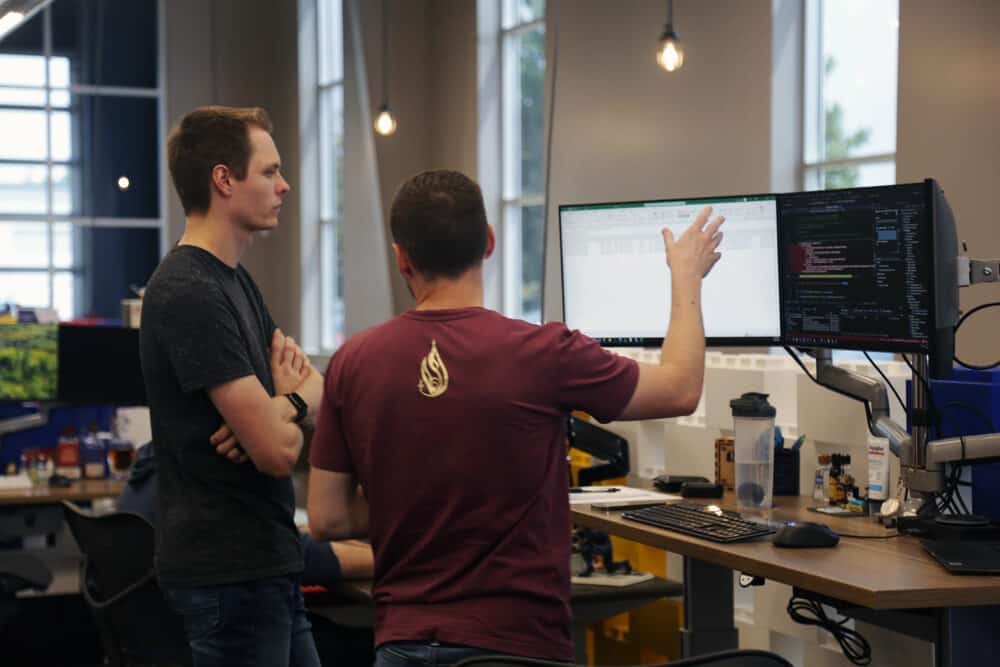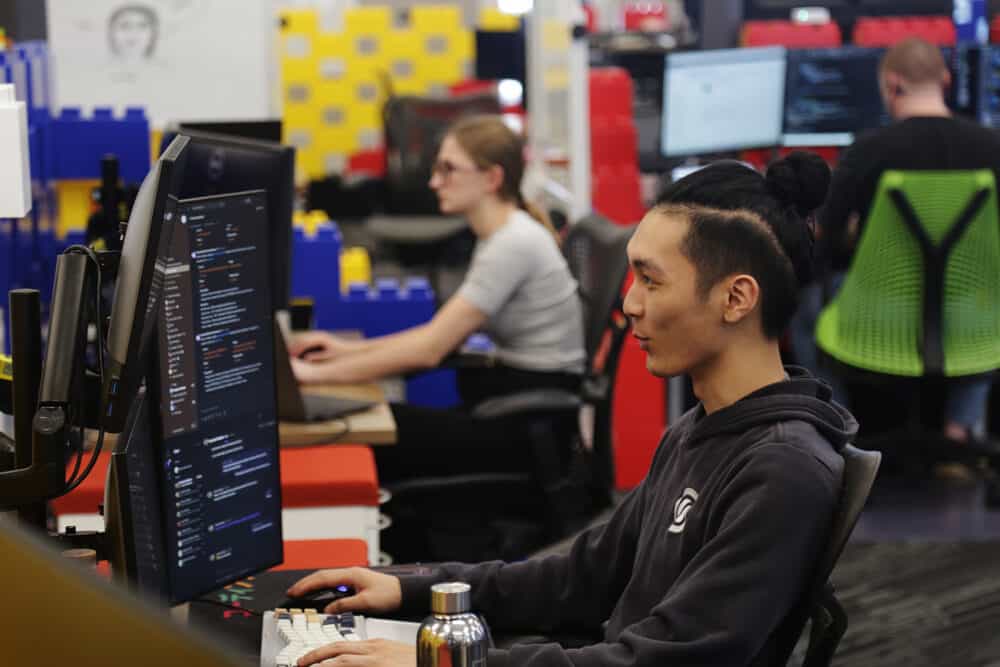In the world of software development, working together is the secret sauce that makes everything better. This way of teaming up isn’t just about getting the job done; give it a shot, and you’ll see it’s like having a brainstorming session and a code check all rolled into one. Every line of code you write together is a mini-lesson in making cool stuff and solving puzzles. Plus, it’s a great way to make sure what you’re building doesn’t just work but shines.
Paired programming is a fast track to learning and professional growth, benefiting junior developers by enhancing their confidence through hands-on experience and immediate feedback. This past spring, I tackled phase 1 of a massive project and felt overwhelmed daily. Only six months into my career, I was faced with new technologies and extensive CMS customization. The challenge seemed impossible, but thanks to paired programming, I saw exponential growth in my skill set and confidence.
Think about paired programming, like teaming up for a two-player video game. You and a buddy sit down, facing the same screen, tackling the same challenges, but with twice the brainpower. You’re joining forces, the experienced player shares hidden strategies and power-ups with the enthusiastic newcomer. This gaming journey reflects the core of paired programming. The senior developer, armed with their arsenal of skills, and the junior, equipped with new ideas, team up to combine experience and innovation. This partnership not only boosts the junior’s skills but also refreshes the senior’s tactics, leading to an innovative solution that could be the next breakthrough in the tech arena.
While on that big project, I found myself in a similar scenario. I was pairing up with multiple senior developers and peers. I was the newcomer, and they were the experienced players, sharing hidden strategies and power-ups. This dynamic transformed my understanding of software development. Several weeks into the project, I reached a turning point. I began taking on tasks independently, seeking assistance only when blocked. This was my level-up moment in the coding quest.
The immediate feedback and hands-on experience were like guardrails, ensuring I stayed on the right path while allowing me the freedom to explore and learn. This safety net was crucial in helping me gain confidence and significantly deepen my understanding of object-oriented programming.
This experience, akin to a gaming journey, reflects the core of paired programming. The partnership between the senior developer, armed with their arsenal of skills, and me, a junior developer with new ideas, boosted my skills and refreshed their tactics. Together, we combined experience and innovation, embodying the essence of paired programming where collaboration leads to breakthrough solutions.

Paired programming is more than just coding together—it’s about supercharging the entire software development process. This collaborative journey brings a multitude of benefits, from enhancing code quality to fostering a vibrant team spirit.
Pair programming transforms the daunting task of debugging into a collaborative puzzle-solving adventure. I recall when I was lost in the depths of an old codebase, far from the familiar terrain of my usual tech stack. Each file seemed a mirror image of the next, devoid of unique identifiers, and I was at a standstill, unable to pinpoint the source of a persistent bug.
Enter my pair programming partner, who introduced me to the Vue.js devtool extension for Google Chrome. This tool became the compass that guided us through the tangled code, allowing us to identify the precise Vue component in need of attention. With this newfound clarity, my confidence surged, and the process accelerated significantly.
This experience was a turning point, highlighting the power of pair programming not just in squashing bugs but in expanding my debugging toolkit. It underscored the importance of leveraging specific tools tailored to the task at hand, a lesson that has since encouraged me to explore and inquire about the array of tools available. Through this mutual learning journey, we not only ensure a more secure and efficient codebase but also foster a culture of continuous growth and curiosity among developers.
Pair programming isn’t just about writing code—it’s about scrutinizing and refining every line in real-time. I remember several times in the last year when this collaborative approach directly impacted the quality of our codebase. One time in particular, I was initially set on building a new feature from scratch, but I encountered small blockers along the way. Fortunately, my pair programming partner—a seasoned developer with a deep understanding of the codebase—suggested a different approach.
Instead of reinventing the wheel, we decided to refine and update the existing codebase to accommodate the new feature. This decision not only streamlined the development process but also resulted in a significant improvement in the overall code quality. Working side by side, I gained invaluable insights into the intricacies of the existing codebase, asking questions and receiving immediate answers that drastically enhanced my understanding.
This collaborative endeavor not only delivered the desired feature but also raised the standard of excellence within our team. By leveraging each other’s expertise and insights, we not only achieved our immediate goals but also set a precedent for continuous improvement and excellence in our coding practices.
Paired programming goes beyond writing code—it’s a masterclass in communication. I recently worked on a task where effective communication played a pivotal role in navigating a challenge. The task involved updating a feature for an existing project, but the acceptance criteria provided by the client was incomplete.
Fortunately, my pair programming partner, who had a longstanding relationship with the client, possessed a keen understanding of their communication style. Drawing from years of experience and a sharp memory of past meetings, he filled in the missing pieces of information, providing crucial context for the task at hand. Additionally, his deep understanding of the codebase guided me in the right direction, ensuring we stayed on track.
This experience underscored the importance of clear and open communication. It encouraged me to actively seek clarification and ask questions when uncertainty arose, fostering a culture of transparency and collaboration. By leveraging each other’s strengths and insights, we not only overcame challenges but also strengthened our bond as a team, paving the way for greater productivity and success.

The prospect of coding with someone might seem intimidating at first, but paired programming is designed to turn these challenges into opportunities for growth. Through structured rotation and fostering an environment of open communication, teams learn to navigate these hurdles, enhancing their cohesion and agility.
The rise of remote work hasn’t diminished the effectiveness of paired programming. Thanks to modern tools like Google Meet and Slack Huddle, teams can seamlessly collaborate regardless of physical distance. As someone who participates in remote pair programming sessions almost weekly, I’ve experienced firsthand how these tools facilitate effective collaboration.
Platforms like Google Meet and Slack Huddle provide essential features like screen sharing, allowing us to easily navigate through code files together. However, remote collaboration does come with its challenges. In an office setting, we might point at the screen to reference a specific line of code, but in a remote environment, we rely on line numbers and identifiers to communicate effectively. Despite these challenges, my pair programming partner and I have adapted our communication methods to overcome these hurdles. This shift in communication has streamlined our remote collaboration process, ensuring that we can work together effectively regardless of our physical location.
Pair programming is more than a method; it’s a journey of growth, fostering not only technical excellence but also personal development, effective communication, and a strong, collaborative team culture. By embracing its principles, addressing its challenges, and leveraging the right tools, software development teams unlock a higher potential. In the grand saga of coding, paired programming is that epic chapter where everyone levels up together, ready to take on the tech world’s challenges as a united front.

We love to make cool things with cool people. Have a project you’d like to collaborate on? Let’s chat!
Stay up to date on what BizStream is doing and keep in the loop on the latest in marketing & technology.